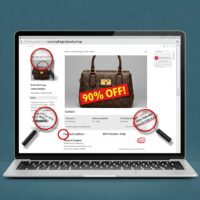Influencer marketing is a booming industry, with brands spending billions of dollars each year to reach consumers through social media influencers. However, this popularity has also made it a target for scammers.
Fake influencer scams are on the rise, and they can be costly for businesses and consumers alike. In 2021, it was estimated that fake influencer scams cost businesses over $1 billion.
There are a number of different ways that fake influencers operate. Some scammers create fake social media accounts that look like they belong to real influencers. They then use these accounts to reach out to businesses and offer to promote their products or services.
Other scammers use real influencer accounts that have been hacked. They then use these accounts to post fraudulent content or to send out spam messages.
In some cases, scammers even create their own fake products or services and then use fake influencers to promote them.
No matter how they operate, fake influencer scams can be difficult to spot. However, there are a few things that businesses and consumers can do to protect themselves:
- Do your research. Before working with any influencer, take the time to research their background and verify that they are who they say they are.
- Look for red flags. If an influencer is offering to promote your products or services for a very low price, or if they are asking for payment upfront, be wary. These are often signs of a scam.
- Check the influencer’s analytics. If an influencer’s follower count or engagement rates seem too good to be true, they probably are.
- Use a third-party platform. There are a number of third-party platforms that can help businesses verify influencers and protect themselves from fraud.
By following these tips, businesses and consumers can help to protect themselves from fake influencer scams.
Here are some additional tips to help you stay safe from fake influencer scams:
- Only work with influencers who have a strong track record of engagement. This means that their followers are actually interested in the content they create, and not just bots or fake accounts.
- Pay attention to the language that the influencer uses. If they are making promises that seem too good to be true, or if they are using aggressive sales tactics, it’s a red flag.
- Ask the influencer for proof of their reach. This could include screenshots of their analytics, or a link to their website traffic data.
- Be sure to have a contract in place that outlines the terms of your relationship with the influencer. This will help to protect you in case of any problems down the road.
By following these tips, you can help to ensure that your business is not a victim of a fake influencer scam.
Here are some of the most common types of fake influencer scams:
- Phishing scams. These scams involve sending emails or messages that appear to be from a legitimate influencer. The emails or messages will often contain a link that, when clicked, will take the victim to a fake website that looks like the influencer’s real website. Once the victim enters their personal information on the fake website, the scammer can steal it.
- Prevention: Be wary of emails or messages that ask for personal information, even if they appear to be from a legitimate influencer. Do not click on any links in these emails or messages, and do not enter your personal information on any websites that you are not familiar with.
- Example: In 2022, a fake influencer account pretending to be Kylie Jenner sent out phishing emails to her followers. The emails asked for the followers’ personal information, such as their email addresses and passwords.
- Reporting: If you think you have received a phishing scam from an influencer, you can report it to the Federal Trade Commission (FTC) at ftc.gov/complaint.
- Scams involving fake products or services. These scams involve fake influencers promoting fake products or services. The products or services may be advertised as being endorsed by the influencer, but they are actually just scams.
- Prevention: Be wary of products or services that are promoted by influencers that you do not know or trust. Do some research on the product or service before you buy it.
- Example: In 2021, a fake influencer account pretending to be Kim Kardashian promoted a fake weight loss product. The product was advertised as being a “miracle” weight loss pill, but it was actually just a scam.
- Reporting: If you think you have been scammed by a fake influencer, you can report it to the FTC at ftc.gov/complaint.
- Scams involving contests or giveaways. These scams involve fake influencers running contests or giveaways that are actually just a way to collect personal information from victims.
- Prevention: Be wary of contests or giveaways that are promoted by influencers that you do not know or trust. Do some research on the contest or giveaway before you enter it.
- Example: In 2022, a fake influencer account pretending to be Rihanna ran a fake giveaway for a new iPhone. The giveaway required victims to enter their personal information, such as their email addresses and phone numbers.
- Reporting: If you think you have been scammed by a fake influencer, you can report it to the FTC at ftc.gov/complaint.
- Scams involving fake reviews. These scams involve fake influencers writing fake reviews for products or services. The reviews are often positive, and they are designed to make the product or service look more appealing than it really is.
- Prevention: Be wary of reviews that are written by influencers that you do not know or trust. Do some research on the product or service before you buy it.
- Example: In 2021, a fake influencer account pretending to be a beauty blogger wrote a fake review for a new skincare product. The review was positive, and it was designed to make the product look more appealing than it really was.
- Reporting: If you think you have seen a fake review from an influencer, you can report it to the FTC at ftc.gov/complaint.
- Scams involving affiliate marketing. These scams involve fake influencers promoting products or services that they do not actually use or endorse. The influencers are paid a commission for each sale that they generate, so they are incentivized to promote products or services that they do not believe in.
- Prevention: Be wary of products or services that are promoted by influencers that you do not know or trust. Do some research on the product or service before you buy it.
- Example: In 2022, a fake influencer account pretending to be an athlete promoted a fake energy drink. The influencer was paid a commission for each sale that they generated, so they were incentivized to promote the drink even though they did not actually use it.
- Reporting: If you think you have been scammed by a fake influencer, you can report it to the FTC at ftc.gov/complaint.
- Scams involving dropshipping. These scams involve fake influencers promoting products or services that they do not actually have in stock. The influencers will often create a fake website that looks like a legitimate retailer. When a victim orders a product from the website, the influencer will simply forward the order to a third-party retailer. The third-party retailer will then ship the product to the victim
If you think you may have been a victim of a fake influencer scam, there are a few things you can do:
- Report the scam to the relevant authorities. This could include the Federal Trade Commission (FTC) or your local law enforcement agency.
- Change your passwords and security settings. This will help to protect your accounts from further unauthorized access.
- Monitor your credit report for any suspicious activity. This will help you to detect any fraudulent charges that may have been made using your personal information.
By following these tips, you can help to protect yourself from the financial and emotional damage that can be caused by fake influencer scams.














